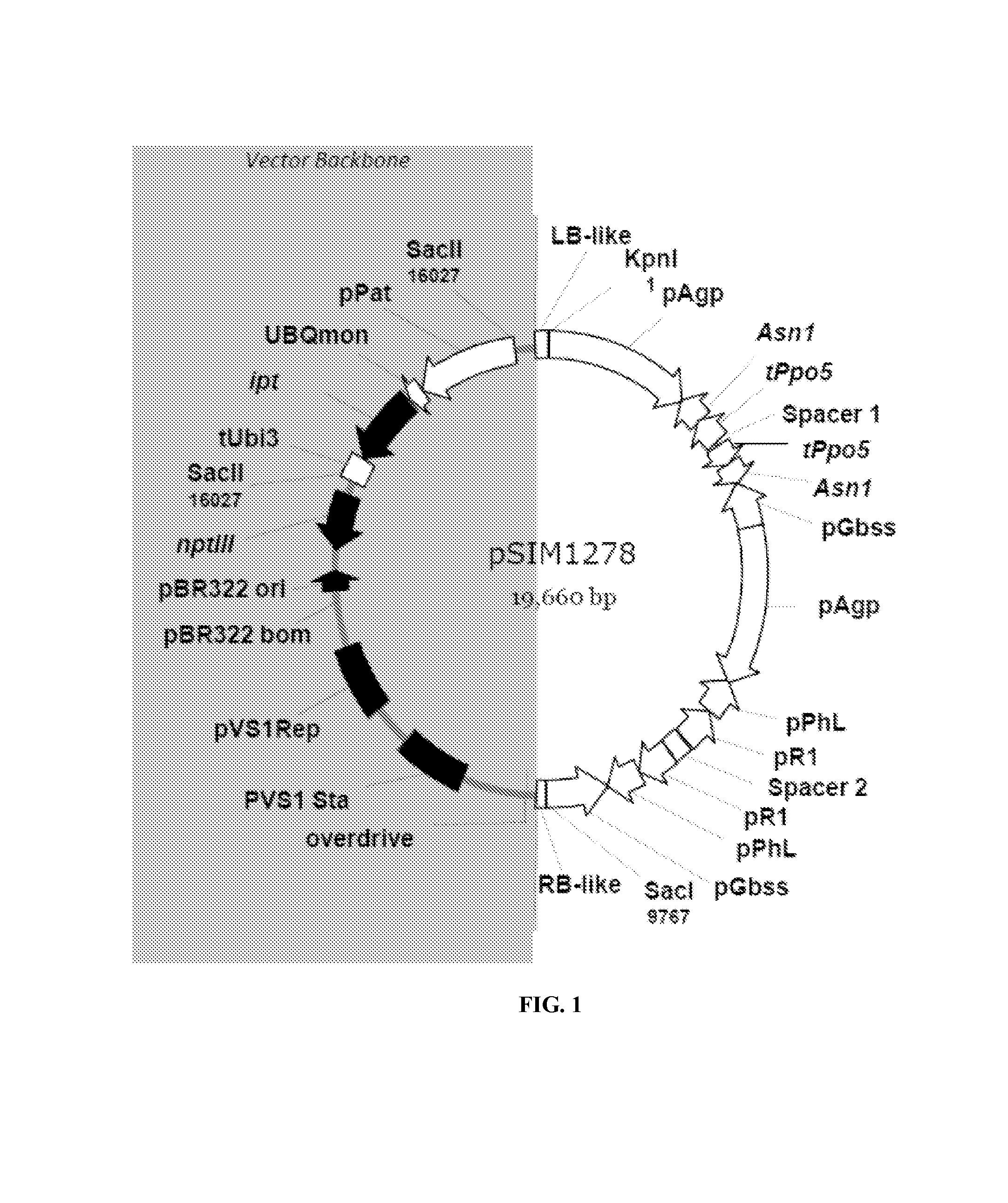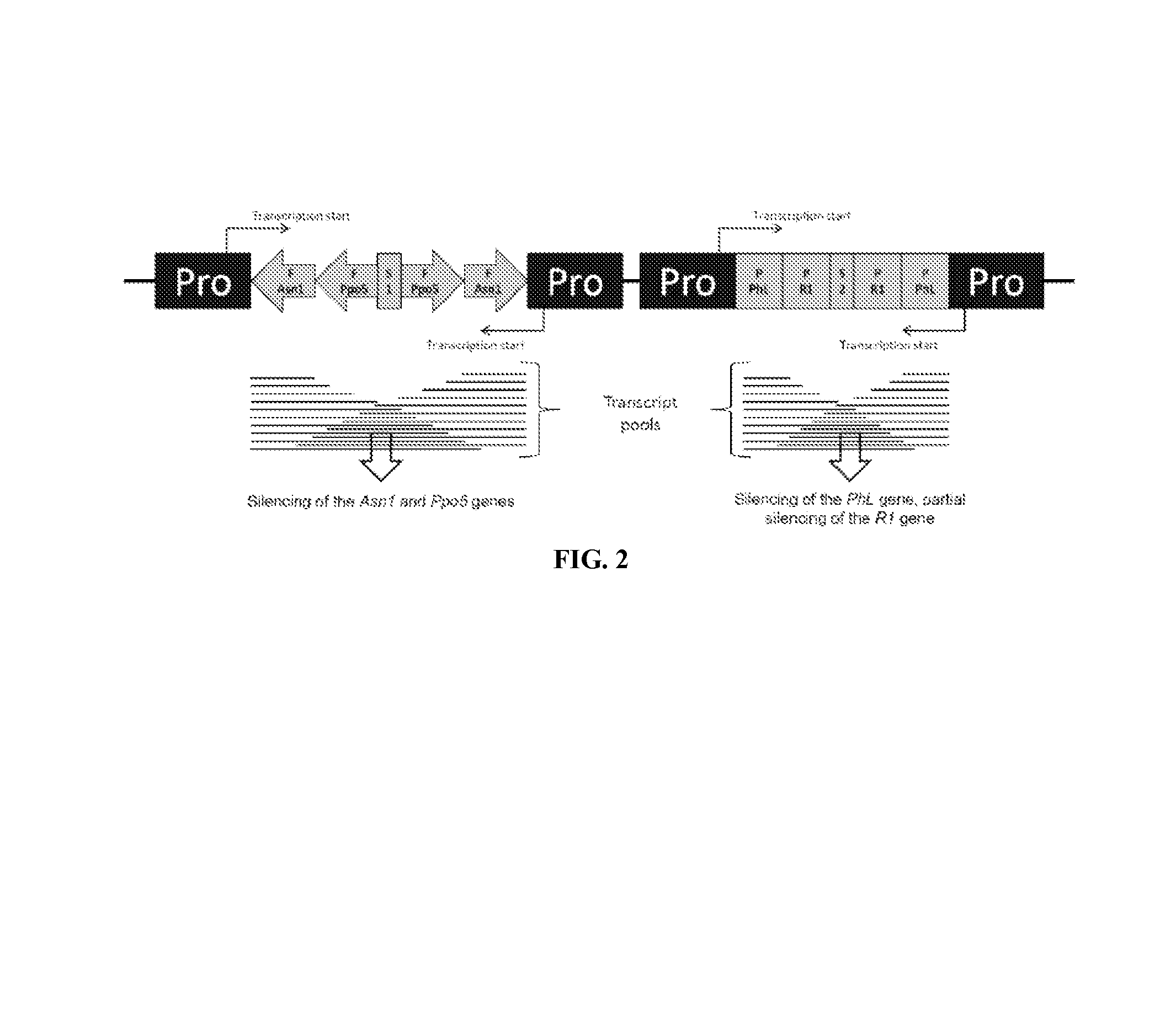Potato cultivar F10
- Summary
- Abstract
- Description
- Claims
- Application Information
AI Technical Summary
Benefits of technology
Problems solved by technology
Method used
Image
Examples
example 1
The pSIM1278 Transformation Vector
[0086]The transformation vector pSIM1278 used in the invention was derived from pSIM106, which was created by ligating a 0.4-kb potato plant DNA fragment (deposited as GenBank accession no. AY566555) with a 5.9-kb SacII-SphI fragment of pCAMBIA1301 (CAMBIA, Canberra, Australia), carrying bacterial origins of replication from plasmids pVS1 and pBR322, and the nptIII gene for bacterial resistance to kanamycin. An expression cassette comprising the Agrobacterium ipt gene preceded by the Ubi-3 promoter (Garbarino and Belknap, 1994) and followed by the Ubi-3 terminator was introduced as a 2.6-kb SacII fragment into the vector backbone (Rommens et al., 2004). Insertion of the native 10-kb DNA segment carrying two silencing cassettes into the DNA insert of pSIM106 yielded pSIM1278. This vector was used for all transformations. The pSIM1278 vector map is shown in FIG. 1. The vector backbone region is 9,511 bp, as it starts at position 9,957 bp and ends at p...
example 2
The Plant DNA Insert and its Open Reading Frames (ORFs)
[0088]The DNA insert region, including the flanking border sequences, used in the pSIM1278 is 10,147 bp long, from 19,469 bp to 19,660 bp and from 1 bp to 9,956 bp. The DNA insert consists of native DNA only and is stably integrated into the potato genome. The DNA insert or a functional part thereof, is the only genetic material of vector pSIM1278 that is integrated in the potato plant varieties of the invention. The DNA insert is described in FIG. 2 and Table 2 below.
[0089]
TABLE 2GenbankStart-EndAccessionPoint inGenetic ElementOriginIntended FunctionNumberpSIM1278ReferenceLeft Border (LB) siteSyntheticSite for secondary cleavage toAY56655519,469-19,493van Haarenrelease single-stranded DNA(bases 1-25)et al. 1989insert from pSIM1278DNA flanking the LB S.tuberosumSupports secondary cleavage AY56655519,494-19,655sequencevar. Rangerat LB(bases 26-Russet187)KpnI restriction siteS.tuberosumSite for connection of DNAAF393847.119,656-1i...
example 3
The Agrobacterium Strain and Transfection
[0091]The C58-derived Agrobacterium strain AGL1 was developed by precisely deleting the transfer DNA of the hyper-virulent plasmid pTiBo542 (Lazo et al., 1991). A transposon insertion in the general recombination gene (recA) stabilizes recombinant plasmid vectors such as pSIM1278 (FIG. 1). AGL1 displays resistance against carbenicillin and rifampicin, and is eliminated from transformed potato tissue using timentin.
[0092]Stock plants of the Ranger Russet variety were maintained in magenta boxes with 40 ml half-strength M516 medium containing 3% sucrose and 2 g / l gelrite (propagation medium). Potato internode segments of four to six mm were cut from four-week old plants, infected with the Agrobacterium AGL1 strain carrying pSIM1278, and transferred to tissue culture media containing 3% sucrose and 6 g / l agar (co-cultivation medium). Infected explants were transferred, after two days, to M404 medium containing 3% sucrose, 6 g / l agar and 150 mg / l...
PUM
| Property | Measurement | Unit |
|---|---|---|
| Electrical resistance | aaaaa | aaaaa |
| Morphology | aaaaa | aaaaa |
Abstract
Description
Claims
Application Information
 Login to View More
Login to View More - R&D
- Intellectual Property
- Life Sciences
- Materials
- Tech Scout
- Unparalleled Data Quality
- Higher Quality Content
- 60% Fewer Hallucinations
Browse by: Latest US Patents, China's latest patents, Technical Efficacy Thesaurus, Application Domain, Technology Topic, Popular Technical Reports.
© 2025 PatSnap. All rights reserved.Legal|Privacy policy|Modern Slavery Act Transparency Statement|Sitemap|About US| Contact US: help@patsnap.com



